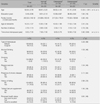Abstract
Methods
With a correlational survey design, 125 postmenopausal women were recruited at the D metropolitan city by a convenience sampling. Fracture risk status was assessed by bone mineral densities (BMD) at lumbar and femur with DEXA method. A structured study questionnaire was used to measure demographic variables, osteoporosis self-efficacy, and fear of falling.
Results
Mean age of the subjects was 59 years old and duration since menopause was 9.55 years. Twenty six percent of the subjects belonged to osteoporotic group in fracture risk status. Mean score for fear of falling was 16.10 (SD=5.18) indicating low level, and osteoporosis self-efficacy for exercise and diet was 44.76 (SD=7.41), indicating mid-range level. Factors influencing the fear of falling was longer time since menopause (β=.30), lower score of osteoporosis self-efficacy for exercise (β=-.26), poor health perception status (β=-.16), and presence of chronic disease (β=.16), and the explained variance was 20%.
Conclusion
Although the level of fear of falling was yet low in postmenopausal women, women who had lower self-efficacy of osteoporosis for exercise and poorer health perception felt greater fear of falling. Therefore, an educational program specific to improve osteoporosis self-efficacy and reduce the fear of falling is needed for improving postmenopausal women's psychosocial well-being.
Figures and Tables
Table 2
Differences in fear of falling and osteoporosis self-efficacy by fracture risk status (N=125)

References
1. Arnold C.M., Busch A.J., Schachter C.L., Harrison L., Olszynski W. The relationship of intrinsic fall risk factors to a recent history of falling in older women with osteoporosis. J Orthop Sports Phys Ther. 2005. 35(7):452–460.

2. Chang C.M., Kang H.S. Physical function and psychological status in the elderly those who experienced a fall or not. Korean J Rehabil Nurs. 2004. 7(1):48–57.
3. Choi J.H. The effects of Tai Chi exercise on physiologic, psychological functions, and falls among fall-prone elderly. 2002. Seoul: The Catholic University of Korea;Unpublished doctoral dissertation.
4. Dargent-Molina P., Benhamou C.L., Cortet B., Sutter B., Thomas T. Devising global strategies for fracture-risk evaluation. Joint Bone Spine. 2007. 74(3):240–244.

5. Faulkner K.A., Cauley J.A., Studenski S.A., Landsittel D.P., Cummings S.R., Ensrud K.E., Donaldson M.G., Nevitt M.C.. for the Study of Osteoporotic Fractures Research Group. Lifestyle predicts falls independent of physical risk factors. Osteoporos Int. 2009. 03. 25. [Epub ahead of print].

6. Huopio J., Kroger H., Honkanen R., Saarikoski S., Alhave E. Risk factor for perimenopausal fractures: A prospective study. Osteoporos Int. 2000. 11(3):219–227.
7. Jeong G.H., Yang S.O., Lee K.O., Pye O.J., Lee M., Baik S.H., Kim K.W. Bone mineral density, health promoting behaviors, and self-efficacy in middle-aged women. Korean J Women Health Nurs. 2003. 9(2):170–178.
8. Jung D.Y. A prediction model of fear of falling in older adults living in a continuing care retirement community in United States. J Korean Geriatr Soc. 2009. 29(1):248–258.
9. Jung D.Y., Shin K.R., Kang Y.H., Kang J.S., Kim K.H. A study on the falls, fear of falling, depression, and perceived health status among the older adults. J Korean Acad Adult Nurs. 2008. 20(1):91–101.
10. Kang T.H., Park Y.K., Kim E.H., Kim S.M., Oh H.J. Spinal bone mineral density related YSM in Korean menopausal women. J Korean Acad Fam Med. 2002. 23(2):224–232.
11. Kim J.S. Influencing factors for fear of falling in degenerative arthritis patients. J Korean Acad Nurs. 2007. 37(7):1184–1192.

12. Kim K., Horan M., Gendler P. Osteoporosis knowledge tests, osteoporosis health belief scale, and osteoporosis self-efficacy scale. 1991. Allendale: Grand Valley State University.
13. 2009 A symposium on osteoporosis with distinguished scholars. 2009. 03. 27. Retrieved August 3, 2009. KMA times;from http://www.kmatimes.com/news/articleView.html?idxno=53649http://www.kmatimes.com/news/articleView.html?idxno=53649.
14. Korean Society of Bone Metabolism. Osteoporosis. 2006. 3rd ed.Seoul: Hanmi Medical Co..
15. Kuczyński M., Ostrowska B. Understanding falls in osteoporosis: The viscoelastic modeling perspective. Gait Posture. 2006. 23(1):51–58.

16. Lee H.Y., Park W.S., Yang H.I. Fear of falling and falls efficacy with bone mineral density in the middle and old aged women. J Muscle Jt Health. 2009. 16(1):5–12.
17. Liu M.R., So H.S. Effects of tai chi exercise program on physical fitness, fall related perception and health status in institutionalized elders. J Korean Acad Nurs. 2008. 38(4):620–628.

18. Murphy S.L., Williams C.S., Gill T.M. Characteristics associated with fear of falling and activity restriction in community-living older persons. J Am Geriatr Soc. 2002. 50:516–520.

19. Nguyen N.D., Frost S.A., Center J.R., Eisman J.A., Nguyen T.V. Development of prognostic nomograms for individualizing 5-year and 10-year fracture risks. Osteoporos Int. 2008. 19(10):1431–1444.

20. Peterson E.W., Cho C.C., von Koch L., Finlayson M.L. Injurious falls among middle aged and older adults with multiple sclerosis. Arch Phys Med Rehabil. 2008. 89(6):1031–1037.

21. Roux C., Priol G., Fechtenbaum J., Cortet B., Liu-Léage S., Audran M. A clinical tool to determine the necessity of spine radiography in postmenopausal women with osteoporosis presenting with back pain. Ann Rheum Dis. 2007. 66:81–85.

22. Shin S.J., Shin K.R., Lee H.R., Ju S.K. Knowledge, health belief, and self-efficacy related to osteoporosis. J Korean Acad Nurs. 2005. 35(5):850–857.

23. Tideiksaar R. Falls in older people: Prevention and management. 2002. 3rd eds. Baltimore: Health Professional Press.
24. Yang S.A. A study on the relationships between osteoporosis knowledge, self-efficacy and health belief of women in urban city. Women Health. 2005. 6(2):19–44.




 PDF
PDF ePub
ePub Citation
Citation Print
Print





 XML Download
XML Download